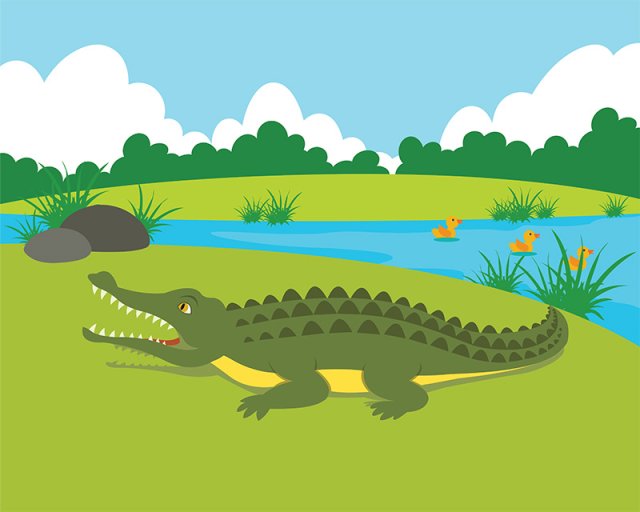Alligators: Ancient Reptiles of Swamps and Rivers
Learn fascinating facts about alligators—their powerful jaws, habitats, diet, behavior, and survival as living fossils. A perfect educational guide for students!

Introduction
Alligators are large, powerful reptiles that belong to the family Crocodylidae, which also includes crocodiles and caimans. Their scientific genus is Alligator, and they have existed on Earth for over 37 million years—making them living fossils. Known for their armored bodies and powerful jaws, alligators are expert hunters and play an important role in wetland ecosystems. There are only two species of alligators: the American alligator (Alligator mississippiensis) and the Chinese alligator (Alligator sinensis).
Physical Description
Alligators have a broad, rounded snout, muscular tails, and thick, scaly skin that provides armor-like protection. They are usually dark gray or blackish in color with lighter underbellies.
- American alligators can grow up to 13–15 feet (4–4.5 meters) long and weigh over 1,000 pounds (450 kg).
- Chinese alligators are smaller, usually around 5 feet (1.5 meters) long.
They have up to 80 sharp teeth, and when their mouths are closed, their upper teeth remain visible, unlike crocodiles whose bottom teeth show more. Alligators have strong jaws, powerful limbs with webbed feet, and a long tail that helps them swim and attack prey.
Alligators have armored skin composed of bony scutes called osteoderms, providing defense and aiding in heat exchange. Their muscular tails power stealthy swims, while webbed feet enable sudden bursts of speed in water. Alligators’ eyes and nostrils sit atop their heads, allowing them to breathe and survey the surface while the rest of their body remains submerged. These reptiles are ectothermic—relying on external heat—so they bask on sunny banks to raise body temperature, and in winter they perform brumation, a turtle-like dormancy under submerged logs or mud, slowing metabolism until warmer weather returns.
Habitat and Diet
Alligators require freshwater wetlands with slow-moving water, abundant vegetation, and secure nesting sites. In the southeastern U.S., they thrive in cypress swamps and river oxbows, while Chinese alligators historically occupied rice paddies and slow streams. Their diet is opportunistic: juveniles feed on insects, fish, and amphibians, while adults take larger prey—fish, turtles, waterfowl, and occasionally deer or feral hogs. Alligators are apex predators, helping control populations of rodents and other aquatic animals, which maintains ecological balance
Reproduction and Lifecycle
Alligator mating season happens in spring, usually between April and June. Males attract females by bellowing loudly and splashing water.
After mating, the female builds a nest of vegetation and mud, where she lays 20–50 eggs. She guards the nest fiercely. The heat from the rotting vegetation incubates the eggs. The temperature of the nest determines the sex of the hatchlings: warmer nests produce males; cooler nests produce females.
After about 60–70 days, the eggs hatch, and the babies make high-pitched noises. The mother helps them out of the nest and may even carry them to the water in her mouth. She continues to protect them for several months.
Alligators can live 35–50 years in the wild, and even longer in captivity.
Behavior and Social Structure
Alligators are usually solitary, but they may gather in groups when basking or during mating season. They are most active at night (nocturnal) and spend their days basking in the sun to warm up their cold-blooded bodies.
They use body movements, sounds, and chemical signals to communicate. Males produce deep bellows during mating season, which can cause the water around them to vibrate!
Alligators are territorial and will defend their area, especially during breeding time. Despite their fierce appearance, they are important for the environment, helping control populations of other animals and maintaining wetland ecosystems.
Threats and Conservation
Alligator populations were decimated in the early 20th century by overhunting for skins and habitat drainage. The American alligator’s status improved dramatically after legal protections in the 1960s, leading to careful management of hunting, habitat preservation, and relocation programs. Chinese alligators remain critically endangered, with fewer than 200 individuals in the wild; conservation depends on wetland restoration, anti-poaching patrols, and breeding releases. Ongoing challenges include wetland loss to development, water pollution, and climate change, which can alter nesting temperatures and sex ratios.
Cultural Significance
Alligators are important in Native American legends, often symbolizing power, protection, and danger. In the southeastern U.S., they are popular in local culture, from football team mascots (like the Florida Gators) to swamp tours and wildlife education.
In ancient Chinese culture, the Chinese alligator may have inspired myths about dragons, due to its scaly body and roaring sounds.
Interesting Facts
- Alligators can replace lost teeth—some grow 2,000–3,000 teeth in a lifetime!
- Their bite force is one of the strongest in the animal kingdom.
- Baby alligators chirp to call their mothers.
- Alligators have a special valve in their throat that lets them hold prey in their mouth without swallowing water.
- Alligator eyes glow red at night when light hits them—a useful trait for spotting them in the dark.
📚 Vocabulary List
Osteoderm A bony deposit forming scales or plates in the skin of some reptiles
Ectothermic Relying on external heat sources to regulate body temperature
Brumation A period of dormancy in cold-blooded animals during winter
Apex predator A top predator with no natural predators
Incubation The process of keeping eggs warm until they hatch
Nest temperature The heat level inside a nest, which determines the sex of alligator hatchlings
Habitat restoration Efforts to return an environment to its natural state
Captive breeding Breeding animals under human care to support wild populations
Bellowing Low, resonant sounds made by male alligators during mating season
Wetland An area of land saturated with water, such as a swamp or marsh
🧒 Kid-Friendly Summary
Alligators are big reptiles that live in swamps, rivers, and marshes. They have rough, armored skin and strong tails to swim quietly in the water. Baby alligators hatch from eggs in nests of plants their mom builds by the water’s edge. In the United States, alligators grow up to 4 meters long and eat fish, turtles, and birds. In China, a smaller kind of alligator is very rare, so people raise them in special centers and hope to release them back into clean wetlands. Alligators sleep through cold months and come back in spring to hunt again. By protecting their homes and following rules about hunting, we help alligators stay safe and share the wetlands with frogs, birds, and fish.
References
- National Geographic – Alligator Facts
- Florida Fish and Wildlife Conservation Commission
- Smithsonian's National Zoo – Reptile Encyclopedia
- IUCN Red List – American and Chinese Alligators
- U.S. Fish & Wildlife Service – Alligator Conservation
🎯 Interactive Quiz: What Do You Know About Alligators?
Which family do alligators belong to?
a) Cheloniidae b) Alligatoridae c) Crocodylidae d) Varanidae
✅ Answer: b) Alligatoridae
What determines a hatchling alligator’s sex?
a) The color of the mother’s nest b) Nest temperature c) Time of day when eggs are laid d) Position in the nest
✅ Answer: b) Nest temperature
What is an osteoderm?
a) A sharp tooth b) A type of egg c) A bony skin plate d) A muscle in the tail
✅ Answer: c) A bony skin plate
Where does the Chinese alligator live in the wild?
a) Mississippi River b) Nile Delta c) Eastern China waterways d) Amazon Basin
✅ Answer: c) Eastern China waterways
What is brumation?
a) A baby alligator’s first swim b) Seasonal dormancy in cold weather c) Courtship display d) Group hunting technique
✅ Answer: b) Seasonal dormancy in cold weather
Why are alligators important to wetlands?
a) They plant new trees b) They eat invasive plants c) They control populations of animals like rodents and fish d) They clean the water with their skin
✅ Answer: c) They control populations of animals like rodents and fish
How long can an alligator live in the wild?
a) 5–10 years b) 15–25 years c) 35–50 years d) Over 100 years
✅ Answer: c) 35–50 years
What helped American alligator numbers recover?
a) Captive breeding and legal protection b) Removing all their predators c) Feeding them in the wild d) Building more nests
✅ Answer: a) Captive breeding and legal protection


















































